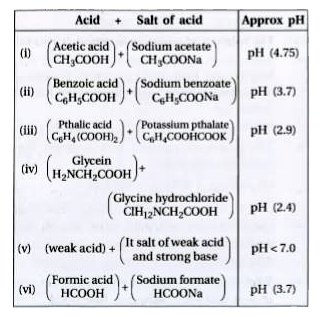What is buffer solutions ? Explain types of buffer solutions by examples.
Text Solution
Defination : The solutions which resist change in pH on dilution or with the addition of small amounts of acid or alkali are called Buffer solutions. Buffer solutions are two types like acidic and basic.
(A)Acidic buffer solutions : The pH value of this solutions is less than 7.0 . The examples of acidic buffer as under.

pH of a acidic buffer is calculate as following :
pH=pKa+log[Salt][Acid]...(Eq.-i)
pH=pKa+log[Conjugate baseA−][Acid HA]....(Eq.-ii)
In it [H3O+]=Ka[HA][A−] ....(Eq.-iii)
This equation is known as Henderson Hasselback equation . Here weak acid HA is ionised in less amount.
(B) Basic buffer solutions : The pH value of buffer solutions is more than 7.0 is known as basic buffer solution . Basic buffer is formed by mixing of weak base and its salt of strong acid. Examples of basic buffer :

pH of basic buffer is calculate by following :
pH=pKw-(pKb + log salt/base) ...(Eq.-i)
pH=pKa−log[Conjugate acidBH+][Base B]....(Eq.-ii)
pOH=pKb+log[Conjugate acidBH+][Base B] ...(Eq.-iii)
=pKb+log[Salt][Base]
...(Eq.-iv)
The pH of buffer solution after dilution does not change as the ratio of exponent factor remain unchange.
|
Topper's Solved these Questions
- EQUILIBRIUMBook:KUMAR PRAKASHANChapter:EQUILIBRIUMExercise:SECTION-A Try Your self -2
Explore 6 Videos
- EQUILIBRIUMBook:KUMAR PRAKASHANChapter:EQUILIBRIUMExercise:SECTION-A Try Your self -3
Explore 10 Videos
- ENVIRONMENT CHEMISTRY Book:KUMAR PRAKASHANChapter:ENVIRONMENT CHEMISTRY Exercise:Question For Module (Section-C)
Explore 1 Video
- HYDROCARBONSBook:KUMAR PRAKASHANChapter:HYDROCARBONSExercise:(Questions for Module (Section - D))
Explore 1 Video
Similar Questions
Knowledge Check
A buffer solution is used in
Apreparation of potash alumBthe removal of PO−34 ionsCincreasing the pH value of a solutionDprecipitation of Cr(OH)3 from CrCl3Which of the following is not an example of buffer solution ?
AHNO2+KNO2BHF+KFCPhNH2+PhNH+3Cl−DNH4Cl+HClWhich solution is not a buffer solution ?
ANaCN ( 2 mole) +HCl ( 1 mole ) in 5LBNaCN (1 mole ) +HCl (1 molde ) in 5LCNH3(2 mole ) +HCl ( 1 mole) in 5LDCH3COOH ( 2 mole) +KOH (1 mole ) in 5L
Which of the following is not an example of buffer solution ?
View SolutionWhich solution is not a buffer solution ?
View SolutionThe pH of an acidic buffer solution & a basic buffer solution at 25∘C is :
View SolutionBy adding a strong acid to the buffer solution, the pH of the buffer solution
View SolutionThe pH of an acidic buffer solution & a basic buffer solution at 25∘C is :
View Solution

